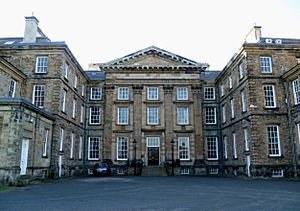Dalkeith Palace facts for kids
Quick facts for kids Dalkeith Palace |
|
|---|---|

Dalkeith Palace in 2004.
|
|
| General information | |
| Architectural style | Dutch Baroque, Neoclassical |
| Town or city | Dalkeith, Midlothian |
| Country | Scotland |
| Construction started | 1701 |
| Completed | 1711 |
| Owner | Buccleuch Living Heritage Trust |
| Design and construction | |
| Architect | James Smith John Adam |
Dalkeith Palace is a grand country house located in Dalkeith, Midlothian, Scotland. For many years, from 1642 until 1914, it was the main home for the powerful Dukes of Buccleuch family. Today, the Buccleuch Living Heritage Trust owns it. The palace you see now was built between 1701 and 1711, right where an old medieval castle once stood.
Contents
Dalkeith Castle: A Royal History
The original Dalkeith Castle was built in the 1100s. It belonged to the Graham family, who were the Lords of Dalkeith. Later, the castle passed to the Douglas family. It was built in a great spot, easy to defend, high above a bend in the River North Esk.
Many important people visited or stayed at Dalkeith Castle:
- In 1503, Margaret Tudor, who was going to marry King James IV, stayed here before entering Edinburgh.
- Mary, Queen of Scots visited Dalkeith in 1565.
- King James VI and his wife, Anne of Denmark, often stayed at the castle. Their daughter, Princess Margaret, was born there on Christmas Eve in 1598.
- In 1633, King Charles I visited and loved the castle so much he thought about buying it! He even started making changes to strengthen it.
Building the New Dalkeith Palace
In 1642, the Earl of Morton sold Dalkeith Castle to Francis Scott, 2nd Earl of Buccleuch.
The 2nd Earl of Buccleuch's daughter, Anne, married James, Duke of Monmouth, who was the oldest son of King Charles II. After her husband faced trouble, Duchess Anne asked a famous architect named James Smith to design a brand new palace. She wanted it to look like William of Orange's palace in Het Loo in the Netherlands.
Building Dalkeith Palace began in 1702. James Smith decided to keep a part of the old castle's tower in the new design. You can still see the outline of the old tower walls on the western side of the palace today!
By 1705, the main part of the palace had its roof. Inside, the Duchess loved marble. A marble sculptor spent a long time carving the main staircase and other beautiful marble pieces, including a detailed carving of Neptune and Galatea. Most of the building work was finished by 1711.
The palace complex also included a fancy iron screen (which is no longer there) and lots of new trees and gardens. The large park, known as Dalkeith Park, later got the Montagu Bridge over the North Esk River and a special glass conservatory. Building the palace cost the Duchess about £17,727, which was a huge amount of money back then!
The palace is made of sandstone. Its main entrance on the south side has two tall columns called Corinthian pilasters. The design of Dalkeith Palace was quite unique for its time.
Famous Visitors and Later Years
Over the centuries, many famous people have stayed at Dalkeith Palace:
- Bonnie Prince Charlie stayed here in 1745.
- King George IV slept here in 1822 during his visit to Edinburgh, choosing it over Holyroodhouse.
- Queen Victoria visited in 1842.
- Edward VII visited in 1899 and 1903.
- George V visited in 1907 and 1910.
During World War II, soldiers from Poland stayed on the third floor of Dalkeith Palace starting in 1942. You can still see some of the drawings and writings (graffiti) they left on the wallpaper today!
The Buccleuch family stopped living in Dalkeith Palace in 1914. For a while, the palace gardens were used for growing vegetables. In the 1970s and early 1980s, a computer company called International Computers Ltd. (ICL) used the palace as an office.
From 1985, the University of Wisconsin used Dalkeith Palace for a study abroad program. Around 60-80 students lived and took classes there each semester. However, this program ended in January 2021.
Images for kids






